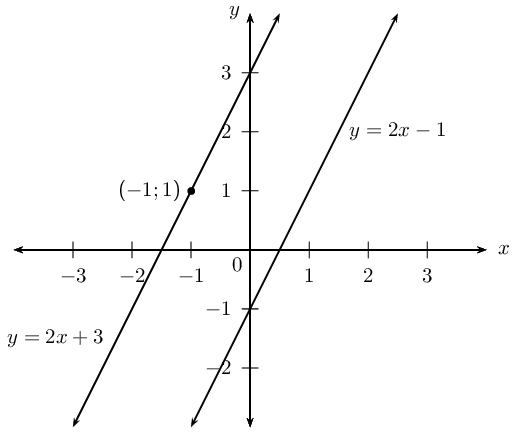\(y + 2 x = 1\) and \(-2x + 3 = y\)
\(\therefore\)Parallel lines.

We think you are located in United States. Is this correct?
We use this information to present the correct curriculum and to personalise content to better meet the needs of our users.
|
Previous
4.3 Inclination of a line
|
Next
4.5 Perpendicular lines
|
Another method of determining the equation of a straight line is to be given a point on the unknown line, \(\left({x}_{1};{y}_{1}\right)\), and the equation of a line which is parallel to the unknown line.
Let the equation of the unknown line be \(y = m_1x + c_1\) and the equation of the given line be \(y = m_2x + c_2\).


If the two lines are parallel then
\[m_1 = m_2\]
Important: when determining the gradient of a line using the coefficient of \(x\), make sure the given equation is written in the gradient–intercept (standard) form.
\[y=mx+c\]Substitute the value of \(m_2\) and the given point \(\left({x}_{1};{y}_{1}\right)\), into the gradient–intercept form of a straight line equation
\[y - y_1 = m(x - x_1)\]
and determine the equation of the unknown line.
Determine the equation of the line that passes through the point \((-1;1)\) and is parallel to the line \(y - 2x + 1 = 0\).
We write the given equation in gradient–intercept form and determine the value of \(m\).
\[y = 2x - 1\]
We know that the two lines are parallel, therefore \(m_1 = m_2 = 2\).
\[y - y_1 = m(x - x_1)\]
Substitute \(m = 2\)
\[y - y_1 = 2(x - x_1)\]
Substitute the given point \((-1;1)\)
\begin{align*} y - 1 & = 2(x - (-1)) \\ y - 1& = 2x + 2\\ y & = 2x + 2 + 1\\ &= 2x + 3 \end{align*}

A sketch was not required, but it is always helpful and can be used to check answers.
The equation of the straight line is \(y = 2x + 3\).
Line \(AB\) passes through the point \(A(0;3)\) and has an angle of inclination of \(\text{153,4}\)\(\text{°}\). Determine the equation of the line \(CD\) which passes through the point \(C(2;-3)\) and is parallel to \(AB\).
Since we are given \(AB \parallel CD\),
\[m_{CD} = m_{AB} = -\text{0,5}\]
\[y - y_1 = m(x - x_1)\]
Substitute the gradient \(m_{CD} = -\text{0,5}\).
\[y - y_1 = -\frac{1}{2}(x - x_1)\]
Substitute the given point \((2;-3)\).
\begin{align*} y - (-3) & = -\frac{1}{2}(x - 2) \\ y + 3 & = -\frac{1}{2}x + 1\\ y & = -\frac{1}{2}x - 2 \end{align*}

A sketch was not required, but it is always useful.
The equation of the straight line is \(y = -\frac{1}{2}x - 2\).
Determine whether or not the following two lines are parallel:
\(y + 2 x = 1\) and \(-2x + 3 = y\)
\(\therefore\)Parallel lines.
\(\frac{y}{3} + x + 5 = 0\) and \(2y + 6x = 1\)
\(\therefore\)Parallel lines.
\(y = 2x - 7\) and the line passing through \((1;-2)\) and \((\frac{1}{2};-1)\)
\(\therefore\)Parallel lines.
\(y + 1 = x\) and \(x + y = 3\)
\(\therefore\)Not parallel lines.
The line passing through points \((-2;-1)\) and \((-4;-3)\) and the line \(-y + x - 4 = 0\)
\(\therefore\)Parallel lines.
\(y - 1 = \frac{1}{3}x\) and the line passing through points \((-2;4)\) and \((1;5)\)
\(\therefore\)Parallel lines.
Determine the equation of the straight line that passes through the point \((1;-5)\) and is parallel to the line \(y + 2x - 1 = 0\).
Determine the equation of the straight line that passes through the point \((-2;-6)\) and is parallel to the line \(2y + 1 = 6x\).
Determine the equation of the straight line that passes through the point \((-2;-2)\) and is parallel to the line with angle of inclination \(\theta = \text{56,31}\text{°}\).
Determine the equation of the straight line that passes through the point \((-2;\frac{2}{5})\) and is parallel to the line with angle of inclination \(\theta = \text{145}\text{°}\).
|
Previous
4.3 Inclination of a line
|
Table of Contents |
Next
4.5 Perpendicular lines
|